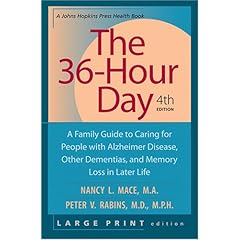 One of the questions I am most frequently asked is if I am worried that my mother might wander away from me and get lost. Wandering is one of the more widely known behaviors of people suffering from Alzheimer’s disease. This article from the Mayo Clinic explains this behavior and some of the likely causes and remedies.
One of the questions I am most frequently asked is if I am worried that my mother might wander away from me and get lost. Wandering is one of the more widely known behaviors of people suffering from Alzheimer’s disease. This article from the Mayo Clinic explains this behavior and some of the likely causes and remedies.Source Mayo Clinic
Alzheimer's: Understand and control wandering
Find out why people with Alzheimer's wander and what you can do to keep them safe.
Alzheimer's disease can erase a person's memory of once-familiar surroundings and make adaptation to new surroundings extremely difficult. As a result, people with Alzheimer's sometimes wander away from their homes or care centers and turn up — frightened and disoriented — far from where they started, long after they disappeared.
Wandering is among the most unsettling and even terrifying behaviors people with Alzheimer's display. Often poorly clad, they leave safety at random hours and strike out into unknown territory, for no apparent reason. But this seemingly aimless activity usually does have a reason. It's often an attempt to communicate after language skills have been lost.
Wandering may communicate something as simple as "I'm feeling lost," or "I feel as though I've lost something." It can also signal such basic needs as hunger and thirst, the need to void, or the need for exercise or rest.
Other causes of wandering:
Too much stimulation, such as multiple conversations in the background or even the noise of pots and pans in the kitchen, can trigger wandering. Because brain processes slow down as a result of Alzheimer's disease, the person may become overwhelmed by all the sounds and start pacing or trying to get away.
Wandering also may be related to:
Medication side effects
Memory loss and disorientation
Attempts to express emotions, such as fear, isolation, loneliness or loss
Curiosity
Restlessness or boredom
Stimuli that trigger memories or routines, such as the sight of coats and boots next to a door, a signal that it's time to go outdoors
Being in a new situation or environment
Tips to prevent wandering
Although it may be impossible to completely prevent wandering, changes in the environment can be helpful. For example, a woman who was a busy homemaker throughout her life may be less likely to become bored and wander if a basket of towels is available for her to fold.
People with Alzheimer's often forget where they are. They may have difficulty finding the bathroom, bedroom or kitchen. Some people need to explore their immediate environment periodically to reorient themselves.
Posting descriptive photographs on the doors to various rooms, including a photo of the individual on the door to his or her own room, can help with navigation inside the home. Offering a snack, a glass of water or use of the bathroom may help identify a need being expressed by wandering. Sometimes the wandering person is looking for family members or something familiar. In such cases, providing a family photo album and sharing reminiscences may help.
Watch for patterns
If wandering occurs at the same time every day, it may be linked to a lifelong routine. For instance, a woman who tries to leave the nursing home every day at 5 p.m. may believe she's going home from work.
This belief could be reinforced if she sees nursing home personnel leaving at that time. A planned activity at that hour, or arranging for staff to exit through a different door at the end of their shift, could provide a distraction and prevent the wandering behavior.
Make a safer environment
If wandering isn't associated with distress or a physical need, you may want to focus simply on providing a safe place for walking or exploration.
Living spaces will be safer after you remove throw rugs, electrical cords, and other potential trip-and-fall hazards. Rearranging furniture to clear space can help. Childproof doorknobs or latches mounted high on doors help prevent wandering outside. Sometimes a stop sign on an exit door is enough.
Rooms that are off-limits pose a different problem. Camouflaging a door with paint or wallpaper to match the surrounding wall may short-circuit a compulsion to wander into such rooms. Night lights and gates at stairwells can be used to protect night wanderers.
Help ensure a safe return
The Alzheimer's Association's Safe Return program is designed to help identify people who wander and return them to their caregiver. Caregivers who pay a $40 registration fee receive:
An identification bracelet
Name labels for clothing
Identification cards for wallet or purse
Registration in a national database with emergency contact information
A 24-hour toll-free number to report someone who is lost
You can register someone by filling out a form online at the Alzheimer's Association's Web page or by calling (888) 572-8566.

No comments:
Post a Comment